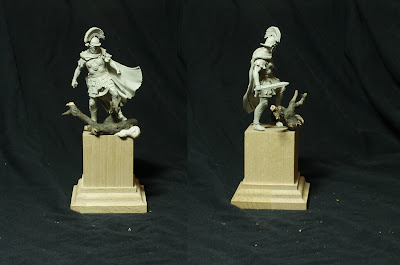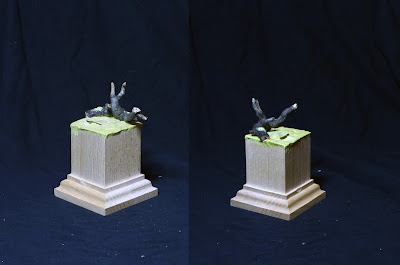Before the actual building will begin, I have to decide the place were the brave centurion will defend the Roman Empire against its manifold enemies. In the first article I already determined, that the little fellow could be dated into the first century AD, probably the first half.
During the first century Rome had to fight some major conflicts:
- The campaign into the barbaric parts of Germania under Varus - trying to conquer germania libera in the year 9 AD, but failing miserably in a bloody defeat in the so called "Battle of the Teutoburg forest", losing 3 whole legions - Boy, what a mess.
- The Conquering of Britain in 43 AD under Claudius - resulting an ever changing boarder until the erection of the Hadrian's Wall in the early twenties of the second century.
- The Great Fire of Rome in 64 AD - okay, not exactly a real campaign or even a battle - but who wouldn't love a mad emperor, that burns down his own capital just for fun and to make space for his new palace, the Domus Aurea - at least some rumors claim so.
- The First Jewish-Roman War between 66-73 - anti-taxation protests escalated and Rome struck back with all its might, executing 6000 Jews and plundering the Second Jewish Temple in Jerusalem - and THAT'S how you get an full-scale rebellion. Some major battles and years later the last Jewish strongholdes were under siege. And Rome could demonstrate it's whole military power in the Sacking of Masada.
- During the same time, namely between 69-70 AD, Rome had also to fight against the revolting Bataver in lower Germania. This uprising was triggered by some political "hiccups" - or one could call it the "year of four emperors" - following the forced suicide of Nero and the struggle for his throne. The riot was ended in the Battle of Xanten and the Status Qou between Rom and the Germanic tribes was reestablished.
- Oh and in 79 AD Pompeii and Herculaneum were destroyed by the eruption of Mount Versuvius. Oh, the gods mast have been so angry with those places.
But back to topic. The list leaves us with 4 major theater's of war, or if you don't like to count Germania two times, with three. We have the desert-like Masada, the lush green meadows of Britannia and the dark forests of Germania. Hm, desert, meadow or forest, good question. Klaus probably would hit me, if I go for a simple desert-base, again. [not that I am afraid of him, but I also am bored by the idear]. So that leaves to possible settings. And since I said something about early first century recently, I'll go with the dark forests of Germania Libera - at least once you have one with that decision Varus......
For those, who went TL;DR - I'm building me a nice small forest base. So what do I need for the first phase of base building:
- The miniature and the plinth of cause. Note, that he has received the first pin to his right foot, the left one will be placed on a rock or a tree branch, so no pin for now. And the head-cape section is just fixed with Pattafix or Blu-tack, so that the base and the final pose of the Roman will fit.
- some Miliput
- cut-off branches of bonsai
- Superglue
- a drill, my trustful hobby knife and saw
- AND the soundtrack of Gladiator, just to get in the right mood
First, a non temporary connection between the Roman and the base is made, hand drill do your job. Next I choose some interesting looking branches and test how they look on the base together with the base. I do so, because I don't want to cut up the pieces just to find they wont fit.
Above you can see three variants I choose. On a deeper thought, I will go with the middle option, of cause, with the soaring twigs cut away. They simply block the view. The other two options are quite interesting, too. But both would cause some minor problems concerning the interaction between miniature and base, as well as the distraction form the miniature itself and are protruding a bit too much. Maybe another brance in the back, we will see. But first some cutting and adding miliput.
The branch is cut and broken, so that it fits more or less on the base. At the parts touching the ground, I tried to cut them as close as possible to the plinth. later on they will be sanded down so that they end with the sides of the plinth. On the other hand, the uprising parts were simply broken off to achieve a rough and natural look.
The surface of the plinth was worked with some Miliput. The space between the branch and the plinth was stuffed first, in order to give it a more natural look as if it has been around for some time, and nature started covering it up. Later on foliage will be added. The rest of the plinth was handled in a similar way, so that a uneven and flowing area emerged. To break up the otherwise regular space, a stone made form Miliput and Fimo was added and integrated.
Another imported fact was the overhang of the Miliput. When dried, this enables me to sand it down evenly later on and create a smooth transition between the added surface and the plinth. For now the work on the base is done because I have to wait until the Miliput has hardened. Than I will sand id down, prime and paint it and at some more fallen leafs and vegetation.
But first its prime time for the Legionary. So stay tuned.






Keine Kommentare:
Kommentar veröffentlichen